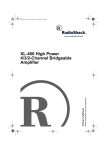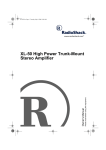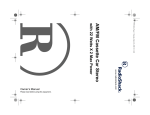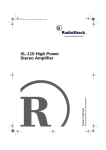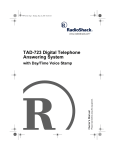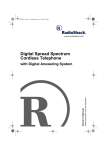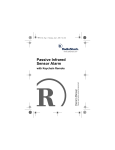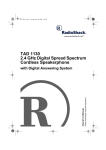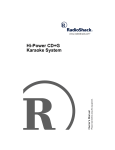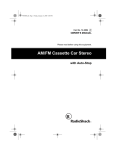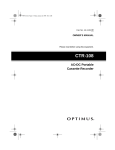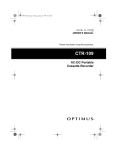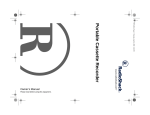Download Radio Shack Flat-Face Car CD Player Owner`s manual
Transcript
12-2118.fm Page 1 Wednesday, May 24, 2000 12:13 PM AM/FM/Cassette Car Stereo Please read before using this equipment. Owner’s Manual with Front Auxiliary Jack and Detachable Front Panel 12-2118.fm Page 2 Wednesday, May 24, 2000 12:13 PM ˆ Contents Features .................................................................................................................................. 3 Installation .............................................................................................................................. Before You Begin the Installation ...................................................................................... Preparing the Mounting Area ..................................................................................... Routing Speaker Wires .............................................................................................. Making the Connections .................................................................................................... Using an Adapter Harness ......................................................................................... Connecting Ground, Power, and Optional Components ............................................ Testing the Power Connections ................................................................................. Connecting an Equalizer or Booster .......................................................................... Connecting Two Pairs of Speakers ............................................................................ Connecting One Pair of Speakers ............................................................................. Connecting the Antenna ............................................................................................ Completing the Connections ...................................................................................... Testing the Connections .................................................................................................... Mounting the Stereo .......................................................................................................... Removing the Stereo from the Dash ................................................................................. Using the Detachable Control Panel ................................................................................. Installing the Control Panel ........................................................................................ Removing the Control Panel ...................................................................................... 4 4 4 4 4 5 5 6 6 6 7 7 7 7 7 8 9 9 9 Operation .............................................................................................................................. 10 Turning the Stereo On and Off ........................................................................................ 10 Setting the Clock ............................................................................................................. 10 Adjusting the Sound/Tuning ............................................................................................ 10 Using an External Audio Component .............................................................................. 11 Radio Operation .............................................................................................................. 11 Playing the Radio ..................................................................................................... 11 Memory Tuning ........................................................................................................ 11 Using the Cassette Player ............................................................................................... 13 Playing a Cassette ................................................................................................... 13 Fast-Forward and Rewind ........................................................................................ 13 Care ....................................................................................................................................... The FCC Wants You to Know ......................................................................................... Tape Tips ......................................................................................................................... Restoring Tape Tension and Sound Quality ............................................................. Cleaning the Tape-Handling Parts ........................................................................... Replacing the Fuses ....................................................................................................... Resetting the Stereo ....................................................................................................... 14 14 14 14 14 14 15 Specifications ....................................................................................................................... 15 © 2000 RadioShack Corporation. All Rights Reserved. RadioShack and RadioShack.com are trademarks used by RadioShack Corporation. 2 Contents 12-2118.fm Page 3 Wednesday, May 24, 2000 12:13 PM ˆ Features Your RadioShack AM/FM/Cassette Car Stereo has an auto-reverse cassette deck and an AM/FM radio with memory and seek tuning, making the stereo easy to use. The tuner's digital synthesized PLL (phase-locked loop) circuitry gives you precise tuning and drift-free reception. Caution: Use common sense. Do not change your stereo's settings in heavy traffic or during hazardous driving conditions. Bass, Treble, Fader, and Balance Controls — let you adjust high and low sounds, the balance between the left and right speakers, and the balance between the front and rear speakers, so you can tailor the sound to suit your preferences. Loudness Control — lets you boost your stereo's high and low frequencies for better sound at low volume levels. Mute Control — lets you attenuate the stereo's sound with the touch of a button. This stereo's features include: Flat-Face Design — provides push-button operation for all controls; there are no knobs to turn. Anti-Theft Control Panel — lets you quickly remove and store the stereo’s control panel in the supplied carrying case. This discourages theft because the stereo cannot operate without the control panel. Front Auxiliary Jack — lets you quickly connect a portable music player (such as a CD [compact disc], MD [mini-disc], or MP3) to the stereo so you can play your favorite music in your vehicle. Line-Level Outputs — let you connect the stereo to external power amplifiers, boosters, or other accessories that have line-level input jacks. Band Button — lets you easily select one of the memory groups in the AM or FM band. Memory Tuning — lets you store into memory up to 12 AM and 18 FM stations so you can quickly tune to those stations. Memory Scan Tuning — scans all stations stored in the selected band, playing for about 5 seconds on each station. Seek Tuning — searches forward or backward to the next strong station in the selected band. Auto Reverse — allows continuous play of both sides of a cassette tape. Locking Fast-Forward/Rewind — let you quickly wind the tape to the end or the beginning without holding down the button. Buzz Alarm — sounds if you connect the speaker wires in such a way that circuit damage could result. Built-In Noise Suppression Choke — reduces the noise caused by your vehicle's electrical system. Liquid Crystal Display with Clock — lets you easily see the stereo's current functions, as well as the time. Features 3 12-2118.fm Page 4 Wednesday, May 24, 2000 12:13 PM ˆ Installation BEFORE YOU BEGIN THE INSTALLATION Cautions: Before you install your stereo, read all the instructions in this owner's manual. You should be able to answer all of these questions about your vehicle's electrical and sound systems. • Which of the stereo's wires is the power wire? • Which terminal in my vehicle's fuse box is for accessories? • How do I connect a wire to the fuse box? • Which stereo wires are line-level outputs and which are speaker outputs? Also, be aware that installation in your vehicle might require cutting or modifying your vehicle. Preparing the Mounting Area Before you mount the stereo, make sure you have all the necessary materials. Then confirm that the stereo fits your vehicle's mounting area. Notes: 4 • Make sure your vehicle's mounting area is as level as possible. • Be sure to avoid obstructions behind the mounting surface. Routing Speaker Wires If you install speakers, avoid routing the speaker wires near moving parts or sharp edges. You can usually route them along the wiring channel beneath the vehicle's door facings by carefully removing the molding that holds the carpet in place. After you route the speaker wires, replace the molding. MAKING THE CONNECTIONS The supplied wiring harness with the 14-pin connector includes all the wires you need to connect the stereo to ground, power, some optional components, and speakers. Important: Do not cut these wires. If you cut any wire, you cannot obtain a refund or exchange on this product. RadioShack will provide warranty service if you cut a wire and find the product is defective. • This auto sound stereo system is a DINE size unit that requires a 21/8 inch (54 mm) high by 73/16 inch (183 mm) wide and 611/16 inch (170 mm) deep mounting area. You might need additional wire to complete the connections, depending on your individual auto sound system. Your local RadioShack store carries a full line of wire and wire management accessories. • If the mounting area is too large, you might be able to mount the stereo with an in-dash installation kit, available at your local RadioShack store. Follow the installation kit's instructions to mount the stereo. Cautions: • For added safety and to protect your stereo, disconnect your vehicle battery's negative (–) cable before you begin. Installation 12-2118.fm Page 5 Wednesday, May 24, 2000 12:13 PM • Be sure your speakers can handle 32 watts of power (16 watts per channel). Each speaker must have an impedance of at least 4 ohms. Your local RadioShack store carries a full line of speakers. • You must connect the GROUND (–), +12V TO IGNITION, and +12V TO BATTERY wires first, then make all other connections as described in the following sections before you plug the harness with the 14-pin connector into the stereo. If you do not make connections in the order shown, damage to the stereo is possible. • You must connect a separate wire to each speaker terminal as described in the following procedure. Do not use a common wire or chassis ground for any speaker connection. Note: Each wire in the wiring harness is a different color and is labeled as shown. White FRONT LEFT White/Black Wiring Harness Using an Adapter Harness If you are replacing an existing stereo, or if your vehicle has been factory-wired for auto sound components, you might be able to use an adapter harness to connect the power and speakers. RadioShack stores sell adapter harnesses for most vehicles. Follow the directions that come with the adapter harness to temporarily connect the power and speakers. Connecting Ground, Power, and Optional Components Follow these steps to connect the supplied wiring harness to ground, primary and memory backup power, and optional components. 1. Disconnect your vehicle battery's negative (–) cable. 2. Connect the black GROUND (–) wire (with filter and fuse box) to a chassis ground, such as a metal screw attached to a metal part of the vehicle's frame. Be sure the screw is not insulated from the chassis by a plastic part. Gray FRONT RIGHT Gray/Black Green REAR LEFT Green/Black 3. Connect the red power (+12V TO IGNITION) wire (with in-line fuse holder) to a point in your vehicle's fuse block that has power only when you turn the vehicle's key to either the accessory (ACC) or START position. Violet REAR RIGHT This connection turns on the stereo when you turn on the ignition or turn the key to ACC, and turns off the stereo when you turn off the ignition. This prevents your vehicle's battery from being drained if you leave the stereo on when you turn off the ignition. Violet/Black Black 5A Yellow GROUND (–) +12V TO BATTERY Blue/White AMP REMOTE TURN ON 500MA MAX 0.5A FUSE Red +12V TO IGNITION 4. Connect the yellow power/memory (+12V TO BATTERY) wire (with filter and fuse box) to your vehicle battery's positive (+) terminal or to a point in your Installation 5 12-2118.fm Page 6 Wednesday, May 24, 2000 12:13 PM vehicle's fuse block that provides a continuous source of 12 volts. 4. Disconnect your vehicle battery's negative (–) cable. This connection provides power for the stereo's components, and continuous power for the stereo's memory when the ignition is turned off. 5. Disconnect the wiring harness from the stereo's 14-pin wiring socket. 5. If you have any optional equipment that you want the stereo to turn on and off (such as a booster or a power antenna), remove the black cover from the end of the blue/white (AMP REMOTE TURN ON 500MA MAX) wire. Then connect the wire to that equipment, as long as it is designed to run from a switched source. Connecting an Equalizer or Booster/Amplifier To connect the stereo to a separate equalizer or booster/amplifier, you will need additional wires (not supplied, available at your local RadioShack store). First, remove the protective covers from the phono connectors on the ends of the stereo's split LINE OUTPUT wire. This wire does not provide power to the components. If you do not use this wire, secure it with a wire tie and do not let it touch metal. Stereo’s Phono Connectors Testing the Power Connections 1. Temporarily connect the wiring harness to the stereo's 14-pin wiring socket. 2. Reconnect your vehicle battery's negative (–) cable. 3. Turn on your vehicle's ignition and install your stereo's control panel (see “Installing the Control Panel” on Page 9). Verify that everything works properly (the stereo works properly when the display lights). Notes: • If the display does not light, immediately turn off your vehicle's ignition and disconnect your vehicle battery's negative (–) cable. Then recheck your connections. • If the stereo works properly, remove your stereo's control panel. 6 For specific instructions about connecting wires to the equalizer or booster, consult the owner’s manual for the equalizer or booster. Connecting Two Pairs of Speakers If you are using both front and rear speakers, follow these steps to connect the wiring harness to the speakers. 1. Connect the white wire to the left front speaker's positive terminal. This terminal is usually marked with a plus (+) sign or a red mark. 2. Connect the white/black wire to the left front speaker's negative terminal. This terminal might be marked with a minus (–) sign or it might not be marked at all. Installation 12-2118.fm Page 7 Wednesday, May 24, 2000 12:13 PM 3. Connect each of the other six wires to its appropriate speaker terminal, as specified by the label attached to each wire (see the diagram in “Making the Connections” on Page 4). Connecting One Pair of Speakers If you are using only one pair of speakers, follow these steps to connect the wiring harness to the speakers. 1. Connect the white wire to the left speaker's positive terminal. This terminal is usually marked with a plus (+) sign or a red mark. 2. Connect the green/black wire to the left speaker's negative terminal. This terminal might be marked with a minus (–) sign or it might not be marked at all. into the stereo's 14-pin wiring socket. Then reconnect your vehicle battery's negative (–) cable. TESTING THE CONNECTIONS Reset your stereo's display (see “Resetting the Stereo” on Page 15). Then install your stereo's control panel (see “Installing the Control Panel” on Page 9). The display should light and you should hear a station through the speakers when you play the radio (see “Playing the Radio” on Page 11). Note: If the display does not light and you do not hear a station, immediately turn off your vehicle's ignition and disconnect your vehicle battery's negative (–) cable. Then recheck your connections. 3. Connect the gray wire to the right speaker’s positive terminal. After you verify that the display lights and you hear a station, follow the instructions in “Mounting the Stereo.” 4. Connect the violet/black wire to the right speaker’s negative terminal. MOUNTING THE STEREO Connecting the Antenna Connect the vehicle's antenna cable to the stereo's large black antenna connector on the back of the stereo. Be sure you verify that the stereo is connected properly (see “Testing the Connections”). Then follow these steps to mount the stereo. 1. Make sure the ignition is turned off, then disconnect your vehicle battery's negative (–) cable. 2. Disconnect the 14-wire harness from the stereo's 14-pin wiring socket, then disconnect the antenna. 3. Press REL (release) on the upper left corner of the control panel and remove the control panel. Antenna Connector 4. Lift the top of the outer trim ring then pull it out to remove it. Vehicle’s Antenna Cable Completing the Connections After you have securely made all other connections, plug the wiring harness' connector 5. The two supplied keys release tabs inside the stereo’s sleeve so you can remove it. One key is marked R (for the Installation 7 12-2118.fm Page 8 Wednesday, May 24, 2000 12:13 PM right side) and the other is marked L (for the left side). Insert the keys as far as they will go (with the notches facing up) into the appropriate slots at the middle left and right sides of the stereo. Then slide the sleeve off the back of the stereo. the supplied metal strap to the mounting bolt on the back of the stereo. If necessary, bend the metal strap to fit your vehicle's mounting area. Then use the supplied sheet metal screw to attach the other end of the strap to a solid metal part of the vehicle under the dashboard. This strap also helps ensure proper electrical grounding of the stereo. Sleeve L Key L Key Mounting Bolt R Key Outer Trim Ring Metal Strap 6. Insert the sleeve into the dash. Then secure the sleeve to the dash by bending out all the tabs with a screwdriver. Tabs 11. Reconnect your vehicle battery's negative (–) cable. Then replace the outer trim ring and install the stereo's control panel. You might need to reset the stereo's clock after you reconnect the vehicle battery’s cable (see “Setting the Clock” on Page 10). REMOVING THE STEREO FROM THE DASH 7. Pull the wiring harness through the front of the sleeve, then reconnect it to the stereo's 14-pin wiring socket. 8. Pull the vehicle’s antenna cable through the front of the sleeve, then reconnect the antenna. 9. Being careful not to pinch any wires or cables, slide the stereo into the sleeve until it locks into place. 10. To further secure the stereo, use the supplied hardware to attach one end of 8 To remove the stereo from the dash, follow these steps. 1. Make sure the ignition is turned off, then disconnect your vehicle battery's negative (–) cable. 2. Remove the metal strap from the back of the stereo (if attached). 3. Press REL to remove the control panel. 4. Lift the top of the outer trim ring then pull it out to remove it. Installation 12-2118.fm Page 9 Wednesday, May 24, 2000 12:13 PM 5. Insert the supplied R (right) and L (left) keys as far as they will go (with the notches facing up) into the appropriate slots at the middle left and right sides of the stereo. Lift up slightly on the keys, then use the keys as handles to pull the stereo part way out of the dash. Grasp the front portion of the stereo with your hand to pull it out the rest of the way. 6. Disconnect the 14-wire harness from the stereo's 14-pin wiring socket, then disconnect the antenna. 7. Reconnect your vehicle battery's negative (–) cable. Slot Tab 2. Gently press the left edge of the control panel into the recess until you hear a click. Removing the Control Panel 1. Press REL until you hear a click. The control panel swings out. USING THE DETACHABLE CONTROL PANEL The stereo's control panel must be in place for the stereo to operate. When you remove it, the display turns off, the stereo cannot be used, and a red indicator flashes. This is a simple but effective security measure. 2. Remove the control panel, then store it in the supplied carrying case. Any stored stations remain in memory when you remove the control panel. Installing the Control Panel Caution: Avoid pushing on the display or pressing any buttons while installing the control panel. 1. Insert the right edge of the control panel into the right edge of the stereo’s front recess. Make sure the tabs in the recess fit into the slots near the edge of the control panel. Caution: To keep the metal connecting pins clean, do not touch the connecting pins in the stereo’s front recess or the back of the control panel. Installation 9 12-2118.fm Page 10 Wednesday, May 24, 2000 12:13 PM ˆ Operation TURNING THE STEREO ON AND OFF SEL (select) — Repeatedly press to select the Volume, Bass, Treble, Balance, or Fader audio setting. To turn the stereo on or off, press PWR (power). VOL (volume) SETTING THE CLOCK 1. If the stereo is off, press PWR to turn it on. 2. The display normally shows the clock. If necessary, press DSP (display) until the clock display appears. 3. Hold down DSP until the time display flashes. (If you do not press a button within about 3 seconds, the display stops flashing.) 4. Repeatedly press TUN/SEK (tune/seek) until the stereo displays the correct hour. (To quickly advance the hour, hold down TUN/SEK .) 5. Then press TUN/SEK until the stereo displays the correct minute. (To quickly advance the minute, hold down TUN/ SEK .) Warning: To protect your hearing, do not listen at high volume levels. Slowly increase the volume to a comfortable listening level. or TUN/SEK — Hold down for TUN/SEK about two seconds to automatically seek the next clear station. Repeatedly press for manual up or down tuning. AMS (automatic memory scan) — Hold down to automatically scan and store the next six strong stations in the selected band, or press to scan all stations stored in a selected memory group (see “Memory Tuning” on Page 11). BND (band) — Press to select the desired band and memory group. LOC (local/DX) — Press to improve reception of a strong station. M/S (monaural or stereo) — press to select stereo or mono reception (FM band only). ADJUSTING THE SOUND/ TUNING LOU (loudness) — Press to boost the audio When you listen to your stereo, adjust these controls to suit your listening preferences and tune the stereo. 10 or VOL — Press to adjust the level of Volume, Bass, Treble, Balance, or Fader. output. MUT (mute) — Press to attenuate the sound. Operation 12-2118.fm Page 11 Wednesday, May 24, 2000 12:13 PM USING AN EXTERNAL AUDIO COMPONENT RADIO OPERATION You can connect a separate audio component, such as a portable CD player, to your stereo, as long as the component has a linelevel output or headphone jack. To make the connection, you need a stereo mini-jack cable with a 1/8 inch (3.5 mm) plug (not supplied, available at your local RadioShack store). Connect one end of the cable to the stereo's AUX in jack, then connect the other end of the cable to the component’s line-level output jack. Playing the Radio 1. Press BND to change between the FM and AM bands. The FM band is divided into three memory groups; the AM band is divided into two memory groups. You can store up to six stations in each memory group. 2. Repeatedly press BND to select a specific memory group. FM1, FM2, or FM3 appears when you select an FM band. AM1 or AM2 appears when you select an AM band. 3. Tune to a station in one of the following ways: Manual Tuning: Repeatedly press TUN/ or TUN/SEK to tune up or down to the desired station. SEK Component’s LineLevel Output or Headphone Jack Stereo’s AUX In Jack or Seek Tuning: Hold down TUN/SEK for about two seconds to TUN/SEK seek the next clear station. When you connect an external audio component then turn it on, you hear the component's sound through your speakers. You can use the stereo's controls to adjust the sound. Notes: • The stereo stops on both strong and weak stations. To limit seek tuning to only strong stations, press LOC until LOC appears. Notes: • If you connect an external audio component's headphone jack to the stereo, adjust the audio component's volume to a low level then adjust the stereo's volume to a comfortable listening level. • When you connect a cable to the stereo's AUX in jack, the radio and cassette player do not operate. PLY appears for about 5 seconds before the clock displays the time. Disconnect the audio component when you are not using it. • When the stereo receives an FM signal, ST appears. The sound is in stereo. 4. Adjust the stereo's controls to suit your listening preferences (see “Adjusting the Sound/Tuning” on Page 10). Memory Tuning You can manually store up to 12 AM and 18 FM stations in memory groups. Each memory group (FM1, FM2, FM3, AM1, and AM2) holds up to six stations. You can manually Operation 11 12-2118.fm Page 12 Wednesday, May 24, 2000 12:13 PM • If the stereo could not find 6 strong stations, it scans again, searching for weaker stations and storing them into any remaining memory locations. enter stations into a memory group, or you can let the stereo search for six stations in a band and automatically enter these into a group. Manually Storing Stations 1. Repeatedly press BND to select the desired memory group (FM1, FM2, FM3, AM1, and AM2). 4. When the stereo has stored all the stations you want or you want to stop searching for stations before all stations are stored, press AMS again. Note: If you do not press AMS, the stereo continues to scan the band, tuning to each stored station for about 5 seconds. 2. Tune to the station you want to store. 3. Hold down the desired memory channel button (1–6). The stereo beeps; continue holding the button. In about 5 seconds you hear another beep and the stereo displays the memory channel number and the selected station’s frequency. Release the button. Selecting a Stored Station To select a stored station, repeatedly press BND to select the desired memory group, then press the desired memory channel button. Automatically Storing Stations 1. Repeatedly press BND until the stereo displays the band and memory group where you want to store a group of stations. For example, to store the first group of AM stations into AM1, repeatedly press BND until AM1 appears. 2. Tune to a frequency just before the first station you want to store. 3. Hold down AMS (automatic memory scan) for about 3 seconds. Beginning where it was last set, the stereo scans the selected band and automatically stores the first 6 strong stations it finds. The memory group number (such as FM2), station frequency (such as 97.7), and memory channel number (such as 3) appear when each station is stored. After all 6 stations are stored, the stereo tunes to the first station and begins to play. Note: Do not hold down the memory channel button. This stores the currently tuned station into that channel. Scanning Stored Stations The radio can scan all stored stations in the selected band, pausing for 5 seconds at each station. It scans all three memory groups in the FM band or both memory groups in the AM band. To start scanning stored stations, briefly press AMS. As the radio scans each memory channel, its channel number flashes. Note: Do not hold down AMS. This causes the radio to automatically store stations into the selected memory group. To stop scanning when the radio pauses on a station you want to listen to, press AMS again. The memory channel number stops flashing. Notes: • The stereo beeps as it stores each station. 12 Operation 12-2118.fm Page 13 Wednesday, May 24, 2000 12:13 PM USING THE CASSETTE PLAYER (fader). Then press VOL or VOL to adjust the selected setting as desired. 6. Press all the way in to stop the tape and eject it. The radio plays. Playing a Cassette Caution: Avoid using C-120 cassette tapes. They are very thin and can easily become tangled in the tape-handling parts. Caution: When you insert a tape into the cassette compartment, the tapehandling parts continue to touch the tape until you press to eject the tape. Be sure you eject the tape as soon as you finish playing it or before you leave your vehicle to release it from the tapehandling parts. This reduces the possibility of a tape being inadvertently tangled or damaged. Follow these steps to play a cassette tape. 1. Take up any slack by turning the cassette's hub with your finger or a pencil. (Avoid touching the tape.) Notes: • When the tape reaches one end, the cassette player automatically changes the tape's direction and plays the other side. Play continues until you press . • During play, you can play the other side of the cassette by pressing and at the same time. 2. If the stereo is off, press PWR to turn it on. Fast-Forward and Rewind 3. Insert the tape into the cassette compartment with its open edge to the right. TAPE or TAPE and PLY appear, and the tape begins to play. To fast-forward or rewind the current side, firmly press or , depending on which side of the tape is playing. The button locks internally and the tape quickly winds in the selected direction. Play resumes when the end of the tape side is reached. To stop fast-forward or rewind before the end of the tape side, gently press the opposite button. Play continues. 4. Press VOL or VOL volume as desired. to adjust the 5. Repeatedly press SEL until the desired audio setting appears — BAS (bass), TRE (treble), BAL (balance), or FAD Operation 13 12-2118.fm Page 14 Wednesday, May 24, 2000 12:13 PM ˆ Care TAPE TIPS To enjoy your RadioShack AM/FM/Cassette Car Stereo for a long time: Restoring Tape Tension and Sound Quality • Keep the stereo dry. If it gets wet, wipe it dry immediately. After you play a cassette tape several times, the tape might become tightly wound on the reels. This can cause playback sound quality to deteriorate. • Handle the stereo gently and carefully. Do not drop it. • Keep the stereo away from dust and dirt. To restore the sound quality, fast-forward the tape from the beginning to the end of one side, then completely rewind it. Then loosen the tape reels by gently tapping each edge of the cassette on a flat surface. • Wipe the stereo with a damp cloth occasionally to keep it looking new. Modifying or tampering with the stereo’s internal components can cause a malfunction and might invalidate its warranty and void your FCC authorization to operate it. If your stereo is not performing as it should, take it to your local RadioShack store for assistance. Caution: Be careful not to damage the cassette when tapping it. Do not touch the exposed tape or allow any sharp objects near the cassette. THE FCC WANTS YOU TO KNOW Cleaning the Tape-Handling Parts • Moving your stereo away from the receiver Dirt, dust or particles of the tape's coating can accumulate on the tape heads and other parts that the tape touches. This can greatly reduce the performance of the cassette player. After about every 20 hours of cassette player operation, clean the tape-handling parts. Insert a special head-cleaning cassette (not supplied, available at your local RadioShack store), and follow the cassette's directions to clean the tape head. • Contacting your local RadioShack store for help REPLACING THE FUSES Your stereo might cause TV or radio interference even when it is operating properly. To determine whether your stereo is causing the interference, turn off your stereo. If the interference goes away, your stereo is causing it. Try to eliminate the interference by: If the stereo does not operate, you might need to replace the red wire's in-line fuse with the supplied 0.5A spare fuse. If the clock resets or stored stations are lost when the ignition is off, you might need to replace the black and yellow wires’ fuse (inside the filter and fuse box) with the supplied 5A spare fuse. Check both fuses. If you cannot eliminate the interference, the FCC requires that you stop using your stereo. 14 Care 12-2118.fm Page 15 Wednesday, May 24, 2000 12:13 PM Caution: Make sure you replace a fuse only with another fuse of the same rating. clip. Then lift the fuse and gently pull it out of the other fuse clip. Note: A fuse's amp rating is stamped on its metal end. Be sure to use the correct spare fuse to replace a failed fuse. Use only 6 × 30millimeter fast-acting fuses. If the fuse is blown, replace it with the supplied 5A spare fuse. Press the fuse into the fuse clips, then close the fuse box. Close the latch by pressing on it until both the right and left sides of the latch snap into place. 1. Disconnect your vehicle battery's negative (–) cable. 2. Lift the long latch on the red wire’s inline fuse holder, then open the holder. Lift the fuse out of the holder by lifting up on the red wires at both ends of the fuse. Remove the fuse from the fuse clips. 4. Reconnect your vehicle battery's negative (–) cable. RESETTING THE STEREO If the stereo locks up, or does not work properly, reset the stereo. If the fuse is blown, replace it with the supplied 0.5A spare fuse. Replace the fuse clips and press the fuse back into the holder. Squeeze the in-line fuse holder together until it latches. 1. If the stereo is on, press PWR to turn it off. 2. Press REL to remove the control panel. 3. Use a pointed object (such as the tip of a pen or a straightened paper clip) to press the small black rectangular RESET button in the lower right portion of the stereo’s front recess. 3. Lift the latch near the bottom edge of the black and yellow wires’ filter and fuse box, then open the box. Use the tip of a pen to lift one end of the fuse out of its 4. Replace the control panel. ˆ Specifications RADIO FM (Nominal) AM (Nominal) Frequency Range 88–108 MHz 530–1710 kHz Frequency Response (±3 dB) 50–12,000 Hz IF Rejection 60 dB 60 dB Image Rejection 48 dB 50 dB Selectivity 35 dB 30 dB Signal-to-Noise (S/N) Ratio 60 dB 48 dB Stereo Separation 30 dB Usable Sensitivity 5.0 µV (50 dB S/N) Specifications 50–2000 N/A 56.23 µV (20 dB S/N) 15 12-2118.fm Page 16 Wednesday, May 24, 2000 12:13 PM CASSETTE PLAYER Cassette Mechanism .............................................................................................................. Auto Reverse Wow and Flutter .................................................................................................... Less than 0.35% WRMS Signal-to-Noise Ratio .......................................................................................................................... 50 dB Separation ........................................................................................................................................... 38 dB Frequency Response (±3 dB) ................................................................................................ 125–8,000 Hz GENERAL Power Source ...................................................................................................... 12V DC Negative Ground Speaker Output Impedance ..................................................................................................... 4 or 8 Ohms Maximum Power: One Pair of Speakers ............................................................................................... 25 Watts/Channel Two Pairs of Speakers ............................................................................................... 7 Watts/Channel Power Output (10% THD @ 1 kHz): One Pair of Speakers ...................................................................................... 16 Watts RMS/Channel Two Pairs of Speakers ...................................................................................... 5 Watts RMS/Channel Chassis Size (HWD) ................................................................. 25/16 × 71/8 × 7 Inches (59 × 181 × 178 mm) Weight .................................................................................................................................. 3.9 lb (1.76 kg) Specifications are typical; individual units might vary. Specifications are subject to change and improvement without notice. Limited One-Year Warranty This product is warranted by RadioShack against manufacturing defects in material and workmanship under normal use for one (1) year from the date of purchase from RadioShack company-owned stores and authorized RadioShack franchisees and dealers. EXCEPT AS PROVIDED HEREIN, RadioShack MAKES NO EXPRESS WARRANTIES AND ANY IMPLIED WARRANTIES, INCLUDING THOSE OF MERCHANTABILITY AND FITNESS FOR A PARTICULAR PURPOSE, ARE LIMITED IN DURATION TO THE DURATION OF THE WRITTEN LIMITED WARRANTIES CONTAINED HEREIN. EXCEPT AS PROVIDED HEREIN, RadioShack SHALL HAVE NO LIABILITY OR RESPONSIBILITY TO CUSTOMER OR ANY OTHER PERSON OR ENTITY WITH RESPECT TO ANY LIABILITY, LOSS OR DAMAGE CAUSED DIRECTLY OR INDIRECTLY BY USE OR PERFORMANCE OF THE PRODUCT OR ARISING OUT OF ANY BREACH OF THIS WARRANTY, INCLUDING, BUT NOT LIMITED TO, ANY DAMAGES RESULTING FROM INCONVENIENCE, LOSS OF TIME, DATA, PROPERTY, REVENUE, OR PROFIT OR ANY INDIRECT, SPECIAL, INCIDENTAL, OR CONSEQUENTIAL DAMAGES, EVEN IF RadioShack HAS BEEN ADVISED OF THE POSSIBILITY OF SUCH DAMAGES. Some states do not allow limitations on how long an implied warranty lasts or the exclusion or limitation of incidental or consequential damages, so the above limitations or exclusions may not apply to you. In the event of a product defect during the warranty period, take the product and the RadioShack sales receipt as proof of purchase date to any RadioShack store. RadioShack will, at its option, unless otherwise provided by law: (a) correct the defect by product repair without charge for parts and labor; (b) replace the product with one of the same or similar design; or (c) refund the purchase price. All replaced parts and products, and products on which a refund is made, become the property of RadioShack. New or reconditioned parts and products may be used in the performance of warranty service. Repaired or replaced parts and products are warranted for the remainder of the original warranty period. You will be charged for repair or replacement of the product made after the expiration of the warranty period. This warranty does not cover: (a) damage or failure caused by or attributable to acts of God, abuse, accident, misuse, improper or abnormal usage, failure to follow instructions, improper installation or maintenance, alteration, lightning or other incidence of excess voltage or current; (b) any repairs other than those provided by a RadioShack Authorized Service Facility; (c) consumables such as fuses or batteries; (d) cosmetic damage; (e) transportation, shipping or insurance costs; or (f) costs of product removal, installation, set-up service adjustment or reinstallation. This warranty gives you specific legal rights, and you may also have other rights which vary from state to state. RadioShack Customer Relations, 200 Taylor Street, 6th Floor, Fort Worth, TX 76102 We Service What We Sell RadioShack Corporation Fort Worth, Texas 76102 12/99 12-2118 05A00 Printed in China
















